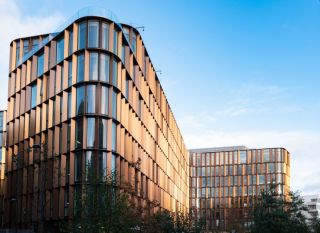An architectural performance that is in tune with its environment
A major economic centre, a first-rate financial centre and an airport mega-hub, Frankfurt am Main has established itself over the centuries as an exciting European metropolis, which has always cultivated its ability to combine contrasts: the city sometimes known as Bankfurt is home to the headquarters of the largest multinationals, the half-timbered houses of Römerplatz, the extraordinary museum collections of the Museumsufer and the twin towers of the ECB. The Senckenberg Tower was conceived in this open, innovative and multi-kulti* spirit.
Designed by the Cyrus Moser architectural firm, this new office building is located on the corner of West-end and Bockenheim, in one of the most vibrant districts of the moment, the Kulturkampus, where a new piece of the city is being invented, just a stone's throw from the Museum of Natural History, the Goethe University and the famous exhibition centre. The Senckenberg Tower, once known as 99 West, is next to another current project (by the same architect), 140 West, which combines luxury housing, a restaurant and a luxury hotel.
By the end of 2021, the Senckenberg Tower will deliver some 30,000 m² of office space designed to accommodate multiple design concepts and meet the growing demand for high quality office space in Frankfurt. Among the first tenants, BNP Paribas S.A. will set up its German headquarters on the lower thirteen floors of the 27-storey tower, taking advantage of the spectacular terrace on the sixth floor. Planted with local species, it is linked to the Schwanheimer Dune, a 60-hectare nature reserve that forms Frankfurt's green belt, just a few minutes from the airport. While the building also has two other accessible terraces (on the 13th and 25th floors) offering a magnificent panorama of the Taunus mountains, the tower is distinguished by its extraordinary façade, 95% of which is made of recycled aluminium.

Get your copy of the Cities of Tomorrow TrendBook
BNP Paribas Real Estate Promotion sets new standards in sustainability
On a European scale, the built environment in all its forms (housing, offices, commercial spaces, warehouses, schools and other public buildings) is the largest consumer of energy and one of the main emitters of carbon dioxide. Collectively, buildings account for 40% of energy consumption and 36%** of greenhouse gas emissions. As Antoine Mabilon, Director of International Property Development & Hotels at BNP Paribas Real Estate, points out, "It is our responsibility to ensure that buildings use energy-efficient materials and have a positive impact on the environment. The choice of recycled aluminium, which is strong, light and durable, is therefore entirely appropriate for this building, which is aiming for BREEAM Excellent certification.
Developed by the Norwegian company Hydro, this innovative material, called Hydro CIRCAL 75R, is made of at least 75% recycled aluminium from post-consumer waste, i.e. dismantled and fully recycled end-of-life joinery. While the production of 1 kilogram of aluminium (from bauxite mining) emits on average about 8.6 kilograms of CO2 per kg of material, Hydro CIRCAL recycled aluminium emits only 2.3 kilograms of CO2 per kg***. In the specific case of the Senckenberg Tower, the overall carbon footprint has therefore been greatly reduced: the use of recycled aluminium will have saved over 2,600 tonnes of CO2.

And of course, beyond its intrinsic qualities, this material provides the urban landscape of the KulturCampus with a skyscraper with pure lines whose undeniable aura attracts all eyes. The office building will be the tallest building in Germany to be clad with recycled aluminium.
Finally, the Senckenberg Tower will also offer a complete range of services to users (a fully digitalised reception area, individually adjustable heated or cooled ceilings, opening windows, top-of-the-range restaurants, electric charging stations and bicycle parking, etc.) and plans to open a gourmet restaurant at the foot of the building. In the long term, nearly 2,500 people will move through this new urban district of Frankfurt every day.
This large-scale project is guided by the six-strong BNP Paribas Real Estate Promotion team based in Frankfurt, whose Country Head is Martin Fäessle, and whose central coordination within the BNP Paribas Group is ensured by Nathalie Neron, Central Director of International Property Development.
With the Senckenberg Tower, BNP Paribas Real Estate Promotion is a perfect example of the company's global innovation approach to designing buildings that have a positive impact on the scale of the building, the district and the city.
* multicultural
** Sources: European Commission / https://ec.europa.eu/info/index_fr
*** Sources: https://www.technal.com/fr

Property development made-to-measure
The cities of tomorrow are being built all around us today. They are smarter, sustainable, innovative and tailored to our ever-evolving ways of life.




